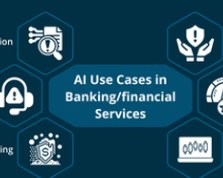What does generative AI do to help with risk assessment in finance?
 A subset of AI known as generative models — those that can create new data or content autonomously and in meaningful ways, holds significant promise to reshape finance completely through automated risk assessment. By leveraging intricate algorithms and a sea of data at its disposal, generative AI can provide real-time minute-to-minute damage reports. This allows FIs (and other businesses) to manage potential problems and opportunities accordingly so they are not left lagging.
A subset of AI known as generative models — those that can create new data or content autonomously and in meaningful ways, holds significant promise to reshape finance completely through automated risk assessment. By leveraging intricate algorithms and a sea of data at its disposal, generative AI can provide real-time minute-to-minute damage reports. This allows FIs (and other businesses) to manage potential problems and opportunities accordingly so they are not left lagging.
1. Improvement in Data Quality and Coverage
Generative AI can generate vast amounts of quality data after being exposed to the dataset, spanning from multiple sources and types by constructing new examples where information is unavailable in a certain set of formats. The importance of this quality cannot be stressed enough, especially in risk assessment situations where the potential for incomplete data or bias can skew results.
2. Scenario Analysis and Stress Testing
In The Finance Industry, How Can Generative AI Assist In Risk Assessment? Generative AI is particularly good at generating many realistic and diverse worlds that can be employed to perform stress tests on models connected with finance. Historical data is only a partial picture of the potential range in future outcomes, which implies that traditional stress testing may not appropriately scale to reflect these gaps. Generative AI can be used to simulate different market conditions, economic shifts, and geopolitical events that corporates in particular have never seen before so they can evaluate how portfolios react under such unforeseen circumstances.
3. Fraud prevention and detection
In other words, in a world focusing most of the time on risk assessment — generative AI can provide incredible assistance and sophistication to help prevent fraud. Through an analysis of patterns and behaviors in transaction data, generative AIs can pinpoint outlier transactions that point to fraud. It can also produce real-looking synthetic fraud scenarios so financial organizations can formally test and improve their detection systems before an adversary has the chance.
4. Credit Risk Assessment
Through the better user profiles that generative AI automatically creates in practice, credit risk assessments can be made significantly more accurate. They report that traditional credit scoring models may only tell some of the story about how a borrower manages their financial behavior and risks. Its generative AI technology allows to generation of entire synthetic profiles, based on new data such as social media activities and transaction histories or employment records.
5. Portfolio Optimization
In The Finance Industry, How Can Generative AI Assist In Risk Assessment? In the process where generative AI generates a spectrum of future states and market conditions, they can aid in optimizing investment portfolios concerning how various realizations on such paths affect asset values. This allows banks to provide a more nuanced evaluation of the risk-reward profiles of various investing strategies.
The finance sector is on the verge of a revolution in how risk assessment will be done and it’s called Generative AI Generative AI helps financial organizations to address risks better by boosting the quality of data that drives all scenario analysis, fraud detection, credit risk assessment refinement as well as directing portfolio optimization.
As technology advances, AI in risk assessment mechanisms will allow for more informed decisions and lead to a healthier financial industry overall.

No Comments
Leave Comment